The American Crocodile: A Story of Recovery
Authors
Michelle P. Moller, Michael S. Cherkiss and Frank J. Mazzotti
Introduction
The American crocodile is a primarily coastal crocodilian occurring in parts of Mexico, Central and South America, the Caribbean, and at the northern end of its range in southern Florida. The crocodile was first sighted by early settlers in the late 1800s in Biscayne Bay. Historically, crocodiles were observed in coastal areas between the present day locales of Key West in the south, Lake Worth in the north, on the east coast and Naples, and Sanibel Island on the West Coast.
Human population growth and development in South Florida is diminishing the restricted distribution of the American crocodile at the northernmost limit of its range.
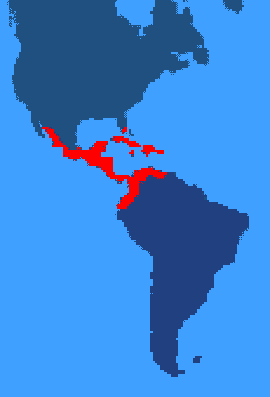
A Comparison of Two Crocodilians
| American Crocodile | vs | American Alligator |
|
|
|
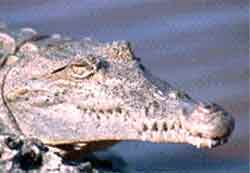 |
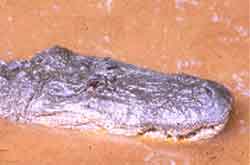 |
Home for a Crocodile
The American crocodile inhabits brackish water and is typically found in ponds, coves, and creeks in mangrove swamps. These areas are characterized by deeper water, low wave action, and intermediate salinities. The creation of man-made habitat, especially nesting sites near natural areas, have been essential for the long-term recovery of crocodiles.
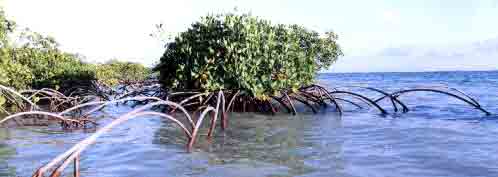
Nestng Behavior and Hatchlings
Nest building occurs in well-drained soil adjacent to water, which prevents flooding and allows for direct access to water. The female begins building a nest in March, and returns repeatedly to complete the nest and then she lays all her eggs during a single night, usually in late April or early May. The number of eggs laid averages 40 eggs per nest. The female will cover all her eggs to protect them from desiccation and predators such as raccoons. She returns in late July or August to open the nest, and she may carry the hatchlings to the water. She may even assist the hatchlings by gently cracking the shells with her jaws.

Survival in the Everglades
Crocodiles feed on small fish, invertebrates, reptiles, birds and mammals. Feeding and growth rates vary with temperature, food availability, and salinity. Diminished freshwater flow to Ever- glades estuaries have negatively affected growth rates of crocodiles.
Occasionally, deaths result from direct or indirect interactions with man, such as collisions with cars. Crocodiles also die from fatal wounds inflicted by other crocodiles or from cannibalism. Survival rates are the lowest for hatchlings, which are faced with many threats from predators (raccoons, birds, crabs), and dehydration. Suitable nesting sites, nursery areas and good year-round habitats are critical to the survival of both
Present Distribution
Crocodiles are found continuously between southern Biscayne Bay and Cape Sable in Everglades National Park, as well as in several locations in southwest Florida between Shark River and Sanibel Island, and in Broward County.
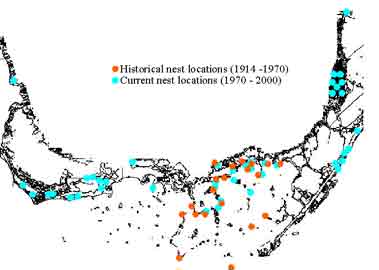
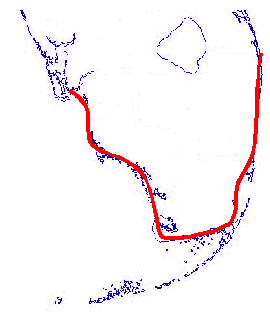
Current nest locations are concentrated between northeast Florida Bay and south Biscayne Bay. Since the 1930s, there has been a gradual disappearance of nesting on islands in Florida Bay, and absence of adults on central Key Largo, and the east coast of Florida north of Biscayne Bay. Nest areas lost to human development have to some extent been compensated by the inadvertent creation of nest sites.
A Rare Species
The American crocodile in Florida has always been rare. Human population growth and development of coastal areas have caused population numbers to be depressed to even lower levels. Humans have built homes in what was once crocodile habitat, mainly affecting the nesting range of crocodiles. By the early 1970s nesting had been restricted to northeastern Florida Bay and north Key Largo. In 1975, Florida's crocodile population was listed as endangered by the US Fish and Wildlife Service. In the late 1970s, intensive studies mainly conducted by the US National Park Service and Florida Game and Fresh Water Commission (now Florida Fish and Wildlife Conservation Commission), and Florida Power and Light Company resulted in a more optimistic outlook for crocodiles in Florida. Largely based on these studies, the National Park Service established a crocodile sanctuary in northeastern Florida Bay. Crocodile Lakes National Wildlife Refuge was created and Florida Power and Light Company began a long term management monitoring program. In 2007, due to an increase in the distribution and number of crocodiles and nests, the US Fish and Wildlife Service downgraded their status in Florida to threatened. In particular the crocodile has made a comeback in southern Biscayne Bay where suitable habitat remains and where habitat modifications have made other areas more favorable for crocodiles, since they can adapt to altered environments.
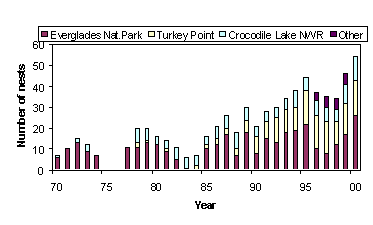
For example, construction of the cooling canal at the Florida Power & Light Company's Turkey Point Power Plant has created nesting habitat where none had existed.
However, the recent increase of the American crocodile is not a permanent success. Environmental changes that affect the ecological health of the Everglades could be detrimental to crocodile populations. Furthermore, crocodiles have been increasingly found in public parks, golf courses and marinas creating conflicts between humans and crocodiles. The result has been the removal of crocodiles from critical habitats. The major challenge for the present and future recovery of crocodiles lies in public education and ecosystem management.
American Crocodile: Crocodylus acutus
Respect their nature - crocodiles are shy and they want to be left alone so observe them from a safe distance.

Everglades Restoration and the Future for Crocodiles
If we continue to protect and restore habitat for crocodiles, South Florida crocodiles will prosper. However, if we are unable to change people's misconceptions about crocodiles and allay their fears, crocodile recovery will become an increasingly difficult task.
The answer lies in linking Everglades restoration with crocodile ecology, the health of the Everglades with the health of crocodile populations, by using crocodiles as indicators of the success of restoring natural freshwater flows to estuaries.
More importantly, we need to educate concerned citizens who feel threatened by the presence of American crocodiles in their neighborhood that conflicts rarely occur unless an animal is provoked. It is possible to coexist peacefully with crocodiles if people are ready to embrace their responsibility to protect an endangered species.
Education promoting the tolerance and understanding of crocodile behavior and habitat has assisted in the survival of crocodiles throughout the world. We should not allow ungrounded fears and lack of awareness to interfere with the recovery of the American crocodile.
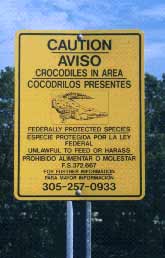
Living with Crocodiles
Safe and responsible behavior: Swim in daylight hours only in areas designated as safe, and never alone. Dispose of fish scraps in garbage bins, and keep your pet away from crocodile-inhabited areas.
Dangerous and irresponsible behavior: Taunting, touching, teasing or attempting to move a crocodile could potentially create a harmful situation, as could swimming in areas with crocodiles.
DO NOT FEED CROCODILES: Feeding crocodiles creates animals that no longer fear humans. Crocodiles will approach other humans for food in the future. Crocodiles can't tell where a handout ends and the hand begins. Feeding a crocodile is a violation of state law. Help spread information by educating others of the dangers of feeding crocodiles and of the proper behavior when around crocodiles.
If you encounter a crocodile, call a regional office of the Florida Fish and Wildlife Conservation Commission for further assistance. It is against the law to attempt to move or otherwise come into contact with a crocodile.
More About This Project
Status, Distribution, and Habitat Relations of the American Crocodile in Florida




